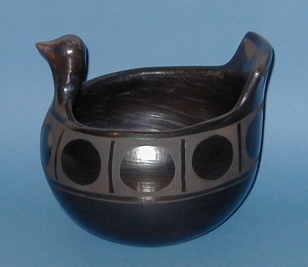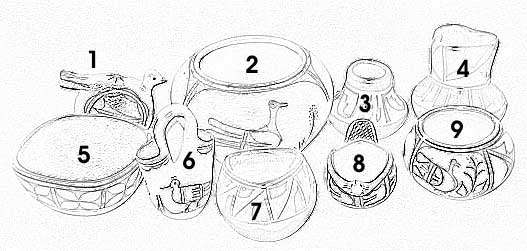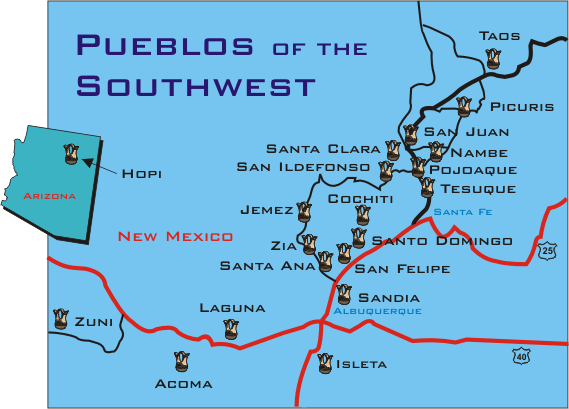 ClayHound Web
- Santo Domingo
Pueblo
ClayHound Web
- Santo Domingo
PuebloReturn to:
|
Santo Domingo Pueblo Pottery |
|
|
|
|
|
|
|
|
Santo Domingo Pueblo is located in north-central New Mexico. Santo Domingo and Cochiti pueblos are the most northeastern of the Keresan language villages. They lie just to the south of Tewa villages and accordingly have felt strong ceramic influences from those neighbors. After the Indian revolt of 1680 this influence became especially strong. Both Santo Domingo and Cochiti discontinued their manufacture of glazeware. For awhile they imported pottery from their Puname (early Zia) and Tewa area, and then gradually these pueblos began to make their own copes of the Tewa styles, using carbon paint for the Tewa-like decorations. The classic type of Tewa-like pottery at Santo Domingo and Cochiti bars the Kiua Polychrome. Kiua is the Indian name for Santo Domingo, and the type was made there principally in the period from 1760 to the present. At Cochiti also the type began about 1760 but by 1830 showed signs of evolving into a different one. By 1850 the style was so distinct that we give it the name Cochiti Polychrome. When some of the potters of Santo Domingo finally began to break from the traditional styles of Kiua Polychrome, the departure was much less extreme than at Cochiti. The resulting vessels, known as Santo Domingo Polychrome, are distinguished from Kiua Polychrome as follows: *The jars are relatively tall, *decoration on the jars is usually not broken up into panels or bands, *red is frequently used in the motifs, *decoration is often naturalistic, with birds and foliage usually predominant, *bowls are rare, few being made. The center picture and the one on the right are more recent pieces. |
|
|
In the legends of the Acoma (OCK-o-ma) peoples, a story is told of the sacred twins leading their ancestors to Ako, the magical white rock which became their permanent home. The twins also discovered and shared with their people, the whitest, finest clay in all the Southwest. Sky City, the old pueblo of Acoma claims to be the oldest continuously occupied settlement in the United States. They may, however, get an argument from the Hopi peoples of Old Oraibi village who also claim this distinction. Thin-walled, large ollas, slipped in pure white and decorated in red and black set the standard for Acoma fine pottery ever since the 18th-century. But that hardly begins to describe the intricate and dramatic designs which characterize modern Acoma pottery. In 1880, the railroad caused a major change in the pottery market. Traders and tourists were unable to travel with the larger ollas, so potters turned to making smaller, eccentric, more manageable pieces. |
|
|
from - http://www.newmexico.org/culture/pueblo_santodomingo.html |
|




